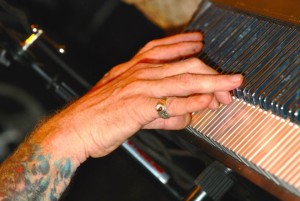I’ve spent the last several months “woodshedding.” For thirty years, I’ve hidden the fact that I was musically illiterate. It’s nothing to be proud of, and last Spring I decided to do something about it.

The whole process began as the result of a present. A friend of mine in California found a book of Albert Ammons piano solos from 1941. I was determined to figure some of them out. From the first page on, I realized I had been playing some of the left hand figures incorrectly. Unfortunately, there were so many notes going in so many directions, three lines below the staff, four spaces above it, and this was just the damn bass (All Cows Eat Grass) clef. In the past, I would have framed the cover and forgot about the rest, but I decided, one last time, to try and teach myself how to read music.
I pulled out my copy of “Alfred’s Adult Piano Course One” and began with “Row, Row, Row Your F-ckin’ Boat.” I felt like a fool, and probably sounded like one. I was in the privacy of my bedroom, and indeed, there are more than a couple of scuff marks on the wall from those first few sessions.
I have severe attention deficit disorder. I am “outing” myself, in the hopes that anyone else with similar problems might benefit some of the practice regimens I used recently that helped me break through some lifelong walls. I have always loved playing music, but sitting down and staying focused has proved almost impossible. On a good day, I have attention span of a Bipolar Ferret in Manic phase, after two cans of Mountain Dew ( and that’s on a good day). The least little jingle from my “smart” phone, outside noise “Lke the idiot next door with the chain saw, what’s he doing? He know we’re not supposed to be, Damn, I remember when I worked at Camp Shenadoah, and that guy From Finland almost cut off his leg with the chain saw, what was his name? Esko, oh yeah, he used to fu… oops, sorry.”
I’m back.
One of my best high school friends ended up at Peabody Conservatory in Baltimore. She practiced eight hours a day, every day, Christmas and Holidays included. Eight hours a day? Even the thought of sitting still and focusing for one hour a day was discouraging. Somebody, somewhere passed on the following:
Set a kitchen timer to fifteen minutes. Just play around for fifteen minutes, but when the timer buzzes, stop. Now, go do something, reward yourself with fifteen minutes of cartoons.
Solid, can do.
Sure enough, the fifteen minutes flew by, and somewhere in the middle of the dreaded key of A Flat, I was saved by the buzzer.
I took a break.
I sat down for another fifteen minutes and played some slow boogie woogie.
BZZZZZZZZZZ
More cartoons.
I took me the better part of three hours, but I put in one whole hour of practice.
I did that four times in the first week.
The second week, I increased the intervals to twenty minutes.
Week Two found me ignoring the buzzer and playing for a few more minutes at the end of each cycle.
I had also begun actually being able to pick out a few of the more familiar notes on the staff in the keys of C, F and G.
I began testing myself while eating dinner. I would draw out a musical staff on the back of an envelope from a bill collector (plenty of those around) and write out the notes on the bass and treble clefs.
I screwed up the nerve to try the Ammons book again. I broke it down by measure, and then by individual note.
Lo and behold, I realized how he played this one lick that I had been trying to figure out for years. I actually got a little emotional. I can do this.
I felt like I had just aced that spelling test in First Grade. Two hours later, my hands were getting tired, and the sun was coming up.
Back in 1967, I bought a book titled “Swing and Progressive Styles for the Piano” by John Mehegan. For some reason, I’ve kept it all these years. I must have looked at no less than a dozen times and given up. Even for someone who reads music, it’s a challenge. This is not “Jazz Made Easy” it’s a serious book for serious players. Joey Defrancisco lists it in the back of his technique book, Horace Silver and Bill Evans wrote the intros. There are transcriptions of Lester Young and Art Tatum (132nd note arpeggios??) solos in the original keys, many of them in the dreaded A Flat. There are sub chords, turn-arounds, numerous standards in numerical transpositions, and page after page of walking tenth chords (a major triad with the third displaced up an octave, requiring a hand stretch of ten notes), and he expects you to learn them in every damn key, along with the relative minors. One of the by-products of my “disorder” is the ability to recognize and utilize patterns. Take away the Pentatonic runs, embellishment tones and chord inversions and most popular music is “Row, Row, Row, Your Boat,” with a Conk. (editor’s note)
On September 28, I will turn Fifty Eight years old. Twelve months ago, I was hobbling around, facing long-term dependence on painkillers and a cane. A lot had changed since then.
Thanks to Dr. Manderson, I no longer need the cane.
Thanks to Dr. Meetze, I no longer need the crutch.
Thanks to Chip Eagle, I have a weekly commitment that demands a clear mind and full faculties.
Thanks to Duane Straub (who gave me the Ammons book), I understand John Mehegan.
…And thanks to John Mehegan, I play a very cool arrangement of “Row, Row, Row Your Freakin’ Boat.”